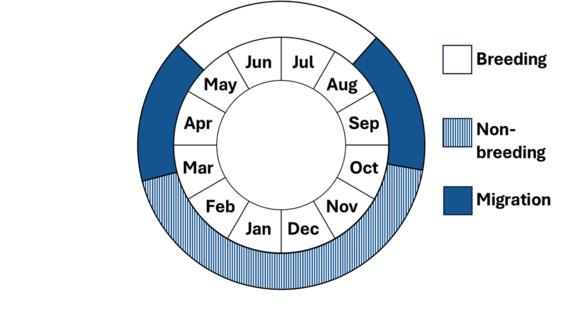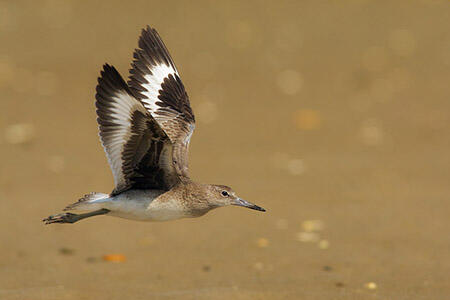- Scientific name: Tringa semipalmata
Species of Greatest Conservation Need (MA State Wildlife Action Plan)
Description

Willet
The willet is a large, brownish-grey sandpiper with long legs, a thick, straight bill, and a short, squared-off tail. Willets average 33–41 cm (12-16 in) long and weigh 200–330 g (7-11.5 oz). While females are slightly larger in mass, the sexes are similar in appearance and overall size. During flight, they display a bold, broad, white wing-stripe bordered in black that runs across the primary and secondary feathers, and a white rump. On the ground they may be confused with other large shorebirds, such as the whimbrel and greater yellowlegs.
Life cycle and behavior

Phenology in Massachusetts. This is a simplification of the annual life cycle. Timing exhibited by individuals in a population varies, so adjacent life stages generally overlap each other at their starts and ends.
Willets are migratory shorebirds. They breed across North America and winter in Central and South America. They depart their wintering grounds starting in March and arrive at their breeding grounds in mid to late spring. Breeding initiation in Massachusetts typically takes place in mid to late May. Willets have one brood per breeding season and lay their eggs in grass nests. The clutch size is typically four eggs, and their incubation period is 22–29 days. Chicks leave the nest within 1–2 days. Males and females share incubation and chick-rearing duties. Willets depart their breeding grounds in Massachusetts in late July and early August. The female departs earlier, with the male completing chick rearing at the nesting site. While the longevity of willets is undetermined, the oldest willet on record was 12 years old.
Willets are generalist feeders and forage day and night. They utilize their long, sensitive bill to feed on crabs, mollusks, worms, insects and other prey in sand and mudflats. They are often seen alone walking slowly and deliberately and will react with a piercing call when startled.
Population status
The global population of willets is estimated at 250,000 mature individuals. Evidence suggests that the population has slightly declined, but some surveys indicate stable populations.
Distribution and abundance
Willets are separated into two, disjunct breeding populations: the western willet (Tringa semipalmata inornate) and the eastern willet (Tringa semipalmata semipalmata). The western willet is found along the western coast of North and South America and breeds in inland, freshwater habitats. The eastern willet was extirpated from Massachusetts during the 1800s due to hunting pressure, but the population has shown a strong recovery since the enactment of the Migratory Bird Treaty Act of 1918. Over the last several decades, the willet has undergone a strong population increase in Massachusetts and can be found nesting along much of the state’s coastline. Willets have an extensive wintering range that includes coastal areas from the southern United States to South America.
Habitat
Eastern willets occupy open beaches, marshes, mudflats and rocky coastal zones along the Atlantic coast. They breed in salt marshes, barrier islands, and barrier beaches. In winter, they migrate south along the coast using beaches, mudflats, and rocky coasts as foraging habitat.
Healthy habitats are vital for supporting native wildlife and plants. Explore habitats and learn about conservation and restoration in Massachusetts.

Threats
The willet’s population may be negatively affected by contaminants and pollutants which accumulate in coastal sediments, and collisions with structures and objects. Both willet subpopulations are impacted by hunting pressures on their wintering grounds. Globally, willets are threatened by non-breeding habitat loss from economic development, which will likely be exacerbated by sea level rise.
Plastic trash in the environment poses a threat as it can be mistaken as food by seabirds and shorebirds and ingested or cause entanglement. Ingested plastics, common for seabirds, can block digestive tracts, cause internal injuries, disrupt the endocrine system, and lead to death. Entanglement from fishing gear and other string-like plastics can cause mortality by strangulation and impairing movements.
Conservation
Eastern willet surveying efforts vary throughout its range. While population monitoring in Massachusetts is limited, nests are censused annually on select breeding locations. Most recently, monitoring efforts of eastern willets have focused on tracking studies. These projects, led by organizations such as the Biodiversity Research Institute, BiodiversityWorks, and the Center for Conservation Biology, focus on identifying migratory routes and stopover and wintering areas. Future management and research needs include the protection of breeding and non-breeding habitat, continued migration studies, and a better understanding of breeding success and adult and juvenile survival. Avoid or recycle single-use plastics and promote and participate in beach cleanup efforts.
References
BirdLife International. “Species factsheet: willet Tringa semipalmata.” 2024. DataZone by BirdLife. https://datazone.birdlife.org/species/factsheet/willet-tringa-semipalmata
Galbraith H., DesRochers D.W., Brown S., and Reed J.M. (2014) Predicting Vulnerabilities of North American Shorebirds to Climate Change. PLOS ONE 9, 9 (2014): e108899.
Huysman, Allison E., Cooper, Nathan W., Smith, Joseph A., Haig, Susan M., Heath, Susan M., Johnson, Luanne, Olson, Elizabeth, Regan, Kevin, Wilson, Jennifer K., and Marra, Peter P. “Strong migratory connectivity indicates willets need subspecies-specific conservation strategies.” Ornithological Applications 124, 3, (2022): 1 – 11.
Lowther, P. E., H. D. Douglas III, and C. L. Gratto-Trevor. “willet (Tringa semipalmata), version 1.0. In Birds of the World (A. F. Poole and F. B. Gill, Editors).” 2020. Cornell Lab of Ornithology, Ithaca, NY, USA. https://doi-org.silk.library.umass.edu/10.2173/bow.willet1.01
Petersen, Wayne R. and Meservey, W. Roger. Massachusetts Breeding Bird Atlas. Amherst: Massachusetts Audubon Society and University of Massachusetts Press, 2003.
Prescott, Robert. “Breeding bird Atlas 1 Species Accounts: willet.” N.d. Mass Audubon. https://www.massaudubon.org/our-work/birds-wildlife/bird-conservation-research/breeding-bird-atlases/find-a-bird-bba1?id=57
Smith, J.A.M., Regan, K., Cooper, N.W. et al. “A green wave of saltmarsh productivity predicts the timing of the annual cycle in a long-distance migratory shorebird.” Scientific Reports 10 (2020): 20658.
United States Geological Survey. “Historical Longevity Records of North American Birds.” N.d. USGS. https://www.pwrc.usgs.gov/BBL/Bander_Portal/login/Longevity_main.php
Contact
| Date published: | April 4, 2025 |
|---|